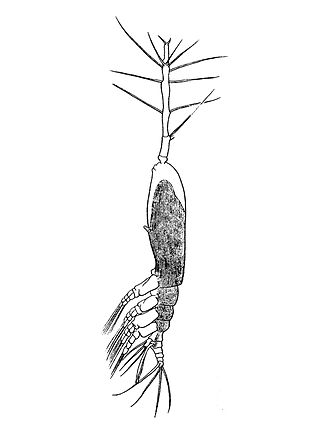The National Polish-American Sports Hall of Fame and Museum was founded in 1973. The mission of the National Polish-American Sports Hall of Fame is to recognize and preserve outstanding achievement by individuals of Polish heritage in the field of sports and to educate the entire community with the hope of encouraging and inspiring personal excellence. The hall is located in Troy, Michigan.

Thecostraca is a class of marine invertebrates containing over 2,200 described species. Many species have planktonic larvae which become sessile or parasitic as adults.

Monstrilloida is an order of copepods with a cosmopolitan distribution in the world's oceans. The order contains a single family, Monstrillidae. The name of the first ever described genus Monstrilla is derived from latin, meaning "tiny monster", because the lack of usual diagnostic features of copepods puzzled early taxonomists.
Rhynchomolgidae is a family of cyclopoid copepods in the order Cyclopoida. There are more than 40 genera and 280 described species in Rhynchomolgidae.
Joseph Casimir Plagens was a Polish-born prelate of the Roman Catholic Church. He served as bishop of the Diocese of Grand Rapids in Michigan from 1941 to 1943.

Facetotecta is a poorly known subclass of thecostracan crustaceans. The adult forms have never been recognised, and the group is known only from its larvae, the "y-nauplius" and "y-cyprid" larvae. They are mostly found in the north Atlantic Ocean, neritic waters around Japan, and the Mediterranean Basin, where they also survive in brackish water.
Przeklęte oko proroka is a Polish historical film. It was released in 1984.

The Cryptoniscidae are a family of isopod crustaceans in the suborder Cymothoida. The original description was made by Kossmann in 1880. "Liriopsidae" is a junior synonym. Members of this family are hyperparasites of rhizocephalid barnacles which are themselves parasites of decapod crustaceans. The morphology of the adult females gives little clue as to their true identity, but the free-living larvae show their true taxonomic affiliations.
The Hemioniscidae are a family of marine isopod crustaceans in the suborder Cymothoida. The original description was made by Bonnier in 1900. Members of this family are parasitic on cirripede barnacles.

Myzostoma is a genus of marine worms in the family Myzostomatidae. They are parasitic on crinoids.

Poecilasmatidae is a family of goose barnacles.

The clade Multicrustacea constitutes the largest superclass of crustaceans, containing approximately four-fifths of all described crustacean species, including crabs, lobsters, crayfish, shrimp, krill, prawns, woodlice, barnacles, copepods, amphipods, mantis shrimp and others. The largest branch of multicrustacea is the class Malacostraca.
Laurida is an order of crustacean in the infraclass Ascothoracida. It consists of the following families and genera:
Lauridae is a family of crustaceans belonging to the order Laurida.
Petrarcidae is a family of crustaceans belonging to the order Laurida.
Ctenosculidae is a family of crustaceans belonging to the order Dendrogastrida.
Gorgonolaureus is a monotypic genus of crustacean with only one species, Gorgonolaureus muzikae.

AZ-12216052 is a drug which acts as a potent and selective positive allosteric modulator of the metabotropic glutamate receptor 8, and is used for research into the role of this receptor subtype in various processes including anxiety and neuropathic pain.
Dendrogaster antarctica is an endoparasitic ascothoracid barnacle of Dendrogastridae that parasitizes on the common Antarctica cushion star, Odontaster validus. It has been found in several sites in Antarctica and was originally discovered by Mark J. Grygier in 1980. He then released an article in 1987 explaining the characteristics of a female member of the species. It was confirmed as an official species in 2003.








